There is a cloud of debris surrounding our solar system. It’s known as the Oort cloud, and it is the source of most of the comets in our solar system. It was first proposed by Jan Oort, as a way to explain why there were so many long-period comets, and why they can appear from almost any direction. It’s estimated that there are about 100 billion small icy bodies in the Oort cloud, spread throughout a sphere about 50,000 AU from the Sun. Through our studies of comets we’ve learned a great deal about the Oort cloud, but we still don’t fully understand how it came to be.
Continue reading “Researchers Simulate the Formation of the Oort Cloud”You Thought Black Hole Event Horizons Looked Strange. Check out Binary Black Hole Event Horizons
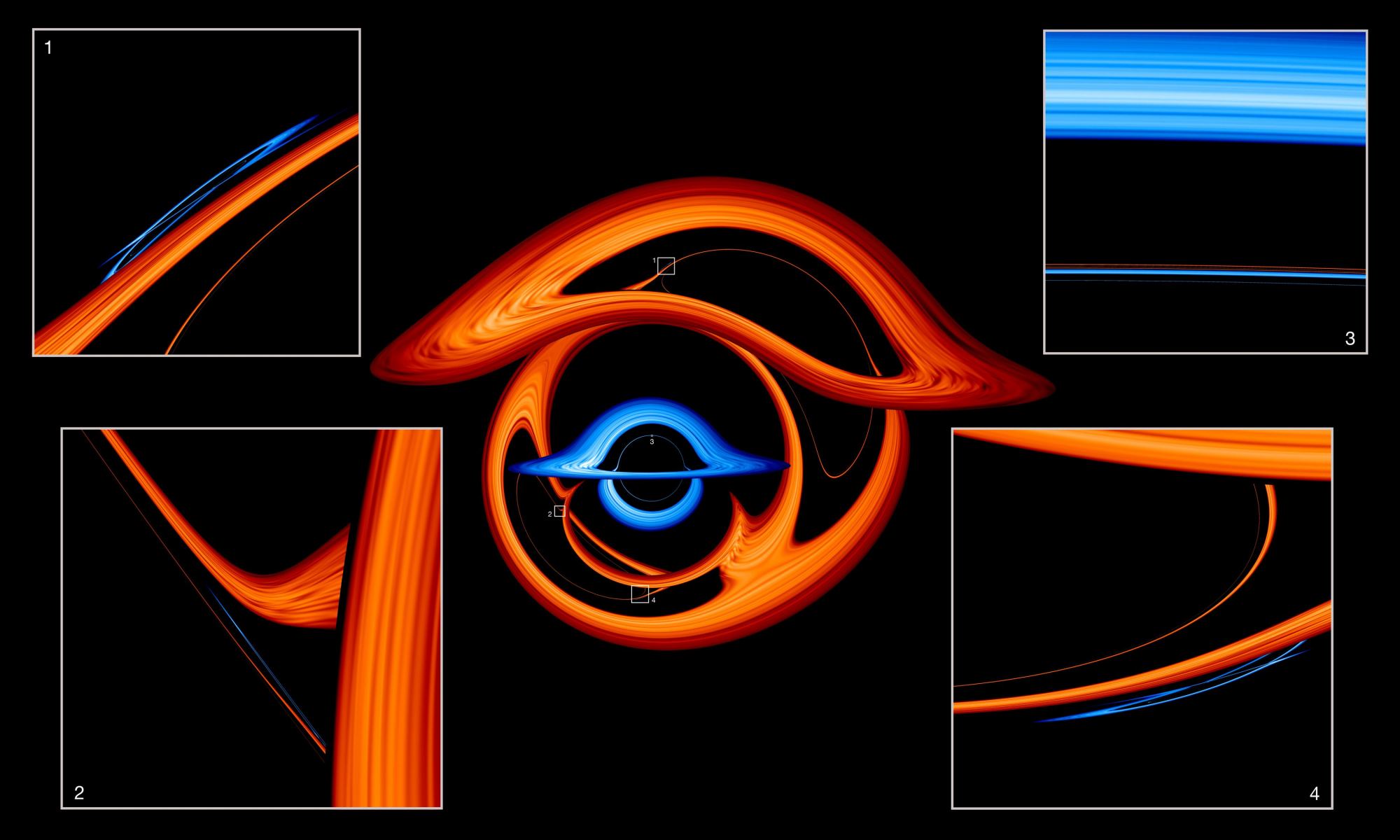
One of the strangest predictions of general relativity is that gravity can deflect the path of light. The effect was first observed by Arthur Eddington in 1919. While the bending effect of the Sun is small, near a black hole light deflection can be significant. So significant that you need a powerful supercomputer to calculate how light will behave.
Continue reading “You Thought Black Hole Event Horizons Looked Strange. Check out Binary Black Hole Event Horizons”Black Holes Gain new Powers When They Spin Fast Enough
General relativity is a profoundly complex mathematical theory, but its description of black holes is amazingly simple. A stable black hole can be described by just three properties: its mass, its electric charge, and its rotation or spin. Since black holes aren’t likely to have much charge, it really takes just two properties. If you know a black hole’s mass and spin, you know all there is to know about the black hole.
Continue reading “Black Holes Gain new Powers When They Spin Fast Enough”Neutrinos Have Played a Huge Role in the Evolution of the Universe
It’s often said that we haven’t yet detected dark matter particles. That isn’t quite true. We haven’t detected the particles that comprise cold dark matter, but we have detected neutrinos. Neutrinos have mass and don’t interact strongly with light, so they are a form of dark matter. While they don’t solve the mystery of dark matter, they do play a role in the shape and evolution of our universe.
Continue reading “Neutrinos Have Played a Huge Role in the Evolution of the Universe”New Simulation Shows Exactly What Dark Matter Would Look Like If We Could See It
How do you study something invisible? This is a challenge that faces astronomers who study dark matter. Although dark matter comprises 85% of all matter in the universe, it doesn’t interact with light. It can only be seen through the gravitational influence it has on light and other matter. To make matters worse, efforts to directly detect dark matter on Earth have been unsuccessful so far.
Continue reading “New Simulation Shows Exactly What Dark Matter Would Look Like If We Could See It”Supercomputer Simulation Shows a Supernova 300 Days After it Explodes

The answers to many questions in astronomy are hidden behind the veil of deep time. One of those questions is around the role that supernovae played in the early Universe. It was the job of early supernovae to forge the heavier elements that were not forged in the Big Bang. How did that process play out? How did those early stellar explosions play out?
A trio of researchers turned to a supercomputer simulation to find some answers.
Continue reading “Supercomputer Simulation Shows a Supernova 300 Days After it Explodes”Supermassive Black Holes Grew by Consuming Gas and Entire Stars
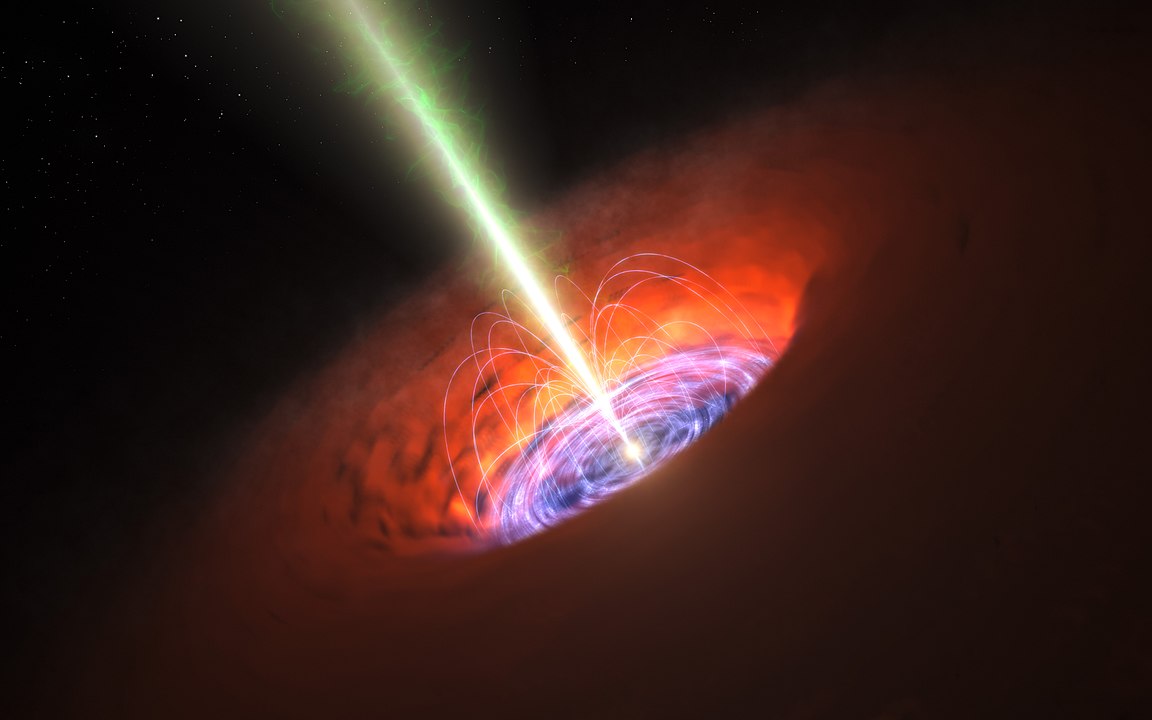
Where do they come from, those beguiling singularities that flummox astrophysicists—and the rest of us. Sure, we understand the processes behind stellar mass black holes, and how they form from the gravitational collapse of a star.
But what about the staggering behemoths at the center of galaxies, those supermassive black holes (SMBH) that can grow to be billions of times more massive than our Sun?
How do they get so big?
Continue reading “Supermassive Black Holes Grew by Consuming Gas and Entire Stars”Student Aids In Tracking Down Near Earth Asteroids
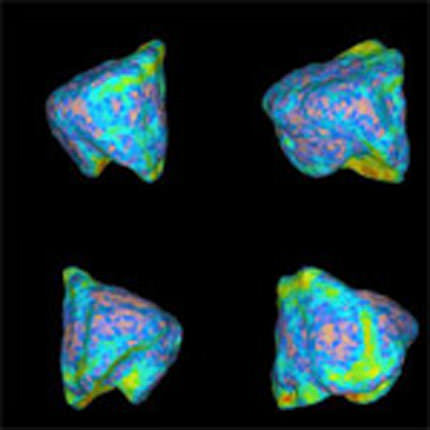
[/caption]
It’s one of the scariest scenarios that could face Earth. Can you imagine an asteroid impact? Even if it were a small event, it could have some far-reaching implications for life of all types here on terra firma. Knowing where and what we might be facing has been of constant concern, but one of the biggest problems is that there isn’t enough “eyes on the skies” to go around. There’s always a possibility that a flying space rock could slip through the proverbial cracks and devastate our planet. But, no worries… We’ve got a student to put to the test!
While most asteroids belong to the Jupiter-orbit class and pose absolutely no danger to Earth, there are exceptions to every rule. Known as Near Earth Objects (NEO), these orbiting stones also share our orbit – and our paths could cross. However, the juxtaposition is that we need to uncover as many of these stragglers as we can, document and track them for the most accurate information possible. Why? We need precise orbital information… A “somewhere in the neighborhood” just won’t do. By knowing exactly what’s out there, we stand a true chance of being able to deflect a problem before it arises. Right now a program headed by Mark Trueblood with Robert Crawford (Rincon Ranch Observatory) and Larry Lebofsky (Planetary Science Institute) is being executed at the National Optical Astronomy Observatory to help catalog NEOs – and it’s being assisted by a Beloit College student, Morgan Rehnberg, who developed a computer program called PhAst (for Photometry and Astrometry) that’s available over the Internet.
Because asteroids have a speedy window of observing opportunity, there can be no delays in reporting and tracking data. Time is of the element. While most astronomy targets are of long term imaging, asteroids require multiple digital images which are viewed via the “blink” method – similar to an old nickelodeon movie. At the same time, the coordinates for the NEO must be perfected and then computed. Right ascension and declination must be absolutely spot on. While there are computer programs currently able to do just that, none of them did exactly what’s required to stake the life of planet Earth on. Even though a better software program was required, there simply wasn’t enough time for the group to write it – but Trueblood saw it as the perfect opportunity for a summer student.
Many of us are familiar with the Research Experience for Undergraduates (REU) program, supported by the National Science Foundation and part of the National Optical Astronomy Observatory (NOAO). Not only has the REU made some fine imaging contributions, but they’ve learned what having a career in astronomy is really like and gone on to become professionals themselves. Enter Morgan Rehnberg, who just happened to have the right computer skills needed to tweak the current image viewer program (ATV, written in the code IDL) . Now you have a recipe for checking out as many images as needed in any order, and perform the astrometric (positional) as well as photometric (brightness) analyses.
While Morgan initially put his new software to use on existing image data, the first test happened this October during an observing session using the 2.1m telescope at Kitt Peak National Observatory. It was definitely a yellow alert when the group happened across a Potentially Hazardous Asteroid (PHA) designated as NEO2008 QT3. This wasn’t just a close rock… this was a rock that was going to pass within 50,000 km of Earth! Thanks to Morgan’s software upgrades, the team was able to correctly compute the brightness and distance of the PHA with 50% of the error margin gone. The resulting positional information was then submitted to the Minor Planet Center and accepted.
It’s a good thing they did it… PhAst!
Original Story Source: NOAO News. The computer program PhAST is available at http://www.noao.edu/news/2011/pr1107.php. In addition to the multi-object support, it contains the ability to calibrate images, perform astrometry (using the existing open source packages SExtractor, SCAMP, and missFITS), and construct the reports for the Minor Planet Center.
Digging Deeper For Dark Matter

[/caption]
Dark matter… If it can’t be seen, then how do we know it’s there? If it wasn’t for the effects of gravity, we wouldn’t. We’d have a galaxy filled with runaway stars and no galaxy would exist for long. But how it behaves and how it is distributed in one of the biggest cosmic cryptograms of all. Even with new research, there seems to be more questions than answers!
“After completing this study, we know less about dark matter than we did before,” said lead author Matt Walker, a Hubble Fellow at the Harvard-Smithsonian Center for Astrophysics.
It is generally accepted that our Universe is predominately composed of dark matter and dark energy. Of the former, it is considered to be “cold”, stately exotic particles which coalesce through gravitation. As they evolve, these dark matter “clumps” then attract “normal” matter which forms present day galaxy structures. Through computer modeling, astronomers have simulated this growth process which concludes that galactic centers should be dense with dark matter. However, these models aren’t consistent with findings. By measuring two dwarf galaxies, scientists have found a even distribution instead.
“Our measurements contradict a basic prediction about the structure of cold dark matter in dwarf galaxies. Unless or until theorists can modify that prediction, cold dark matter is inconsistent with our observational data,” Walker stated.
Why study a dwarf instead of a spiral? In this case, the dwarf galaxy is a perfect candidate because of its composition – 99% dark matter and 1% stars. Walker and his co-author Jorge Penarrubia (University of Cambridge, UK) chose two nearby representatives – the Fornax and Sculptor dwarfs – for their study. In comparison to the Milky Way’s estimated 400 billion stars, this pair averages around 10 million instead. This allowed the team to take a comprehensive sample of around 1500 to 2500 stars for location, speed and basic chemical composition. But even at a reduced amount, this type of stellar accounting isn’t exactly easy picking.
“Stars in a dwarf galaxy swarm like bees in a beehive instead of moving in nice, circular orbits like a spiral galaxy,” explained Penarrubia. “That makes it much more challenging to determine the distribution of dark matter.”
What the team found was somewhat surprising. According to the modeling techniques, dark matter should have clumped at the core. Instead they found it evenly distributed over a distance measuring several hundred light years across.
“If a dwarf galaxy were a peach, the standard cosmological model says we should find a dark matter ‘pit’ at the center. Instead, the first two dwarf galaxies we studied are like pitless peaches,” said Penarrubia.
It is hypothesized that interactions between normal and dark matter might be responsible for the distribution, but the computer simulations say it shouldn’t happen to a dwarf. New queries to new findings? Yes. This revelation may suggest that dark matter isn’t always “cold” and that it could be impacted by normal matter in unexpected ways.
Original Story Source: Harvard Smithsonian Center for Astrophysics News Release. For Further Reading: A Method Of Measuring (Slopes Of) the Mass Profiles of Dwarf Spheroidal Galaxies.
The Genesis of Galaxy Eris…
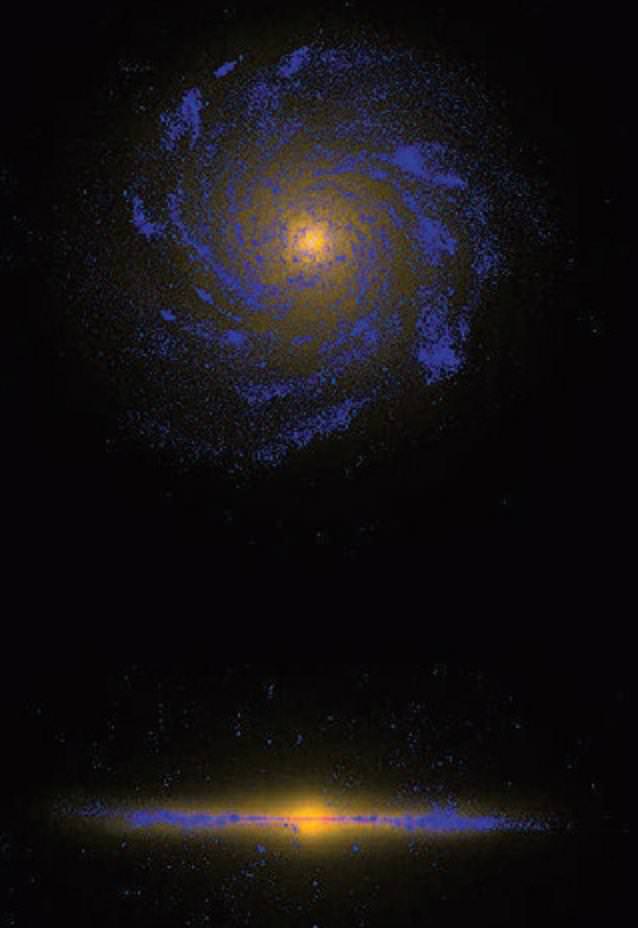
[/caption]
In as much time as it takes to give birth to human life, a supercomputer and a team of researchers at the University of California, Santa Cruz, and the Institute for Theoretical Physics in Zurich have given rise to the first simulation of the physics involved in galaxy formation that produced the Milky Way. They named their child Eris…
“Previous efforts to form a massive disk galaxy like the Milky Way had failed, because the simulated galaxies ended up with huge central bulges compared to the size of the disk,” said Javiera Guedes, who recently earned her Ph.D. in astronomy and astrophysics at UC Santa Cruz and is first author of a paper which has been accepted for publication in the Astrophysical Journal.
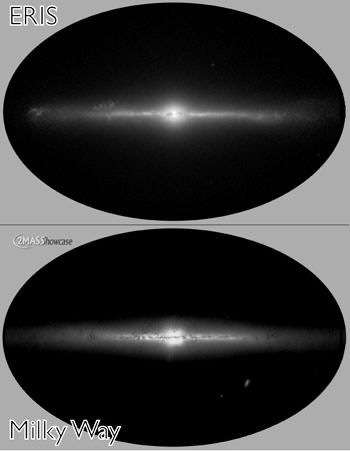
And “seven sisters” were involved in the project, too. NASA’s state-of-the-art Pleiades supercomputer took on the task of 1.4 million processor-hours. But the calculations didn’t stop there. Simulations on supercomputers at UCSC and the Swiss National Supercomputing Center were involved, too. “We took some risk spending a huge amount of supercomputer time to simulate a single galaxy with extra-high resolution,” Madau said.
For over two decades, attempts at creating the evolution of a Milky Way type galaxy have been just outside the grasp of researchers. They just weren’t able to produce the proper shape, size and population to fit known properties. Thanks to this new breakthrough, support for the “cold dark matter” theory has predominated and the Big Bang theory supported. What gave Eris the edge? Try our now better understanding star formation.
“Star formation in real galaxies occurs in a clustered fashion, and to reproduce that out of a cosmological simulation is hard,” Madau said. “This is the first simulation that is able to resolve the high-density clouds of gas where star formation occurs, and the result is a Milky Way type of galaxy with a small bulge and a big disk. It shows that the cold dark matter scenario, where dark matter provides the scaffolding for galaxy formation, is able to generate realistic disk-dominated galaxies.”
Giving birth to Eris wasn’t an easy task. Through low-resolution simulations, researchers began assembling clumps of dark matter – shaping them into galactic halos. From there they selected information on a halo with similar mass and merger history to our own and “rewound the tape” to its infancy. By focusing on a small area, they were able to add additional particle information and step up the resolution.
“The simulation follows the interactions of more than 60 million particles of dark matter and gas. A lot of physics goes into the code–gravity and hydrodynamics, star formation and supernova explosions–and this is the highest resolution cosmological simulation ever done this way,” said Guedes, who is currently a postdoctoral researcher at the Swiss Federal Institute of Technology in Zurich (ETH Zurich).
What sets Eris apart from its predecessors is the ability to “see” in high resolution / high density. This allows for a more pragmatic approach to star formation and placement. It’s an important consideration, because supernova occur in high density regions and high resolution allows them to be taken into account.
“Supernovae produce outflows of gas from the inner part of the galaxy where it would otherwise form more stars and make a large bulge,” Madau said. “Clustered star formation and energy injection from supernovae are making the difference in this simulation.”
Arise, Eris… Your time has come!
Original Story Source: University of Santa Cruz News. For Further Reading: Forming Realistic Late-Type Spirals in a LCDM Universe: The Eris Simulation.




